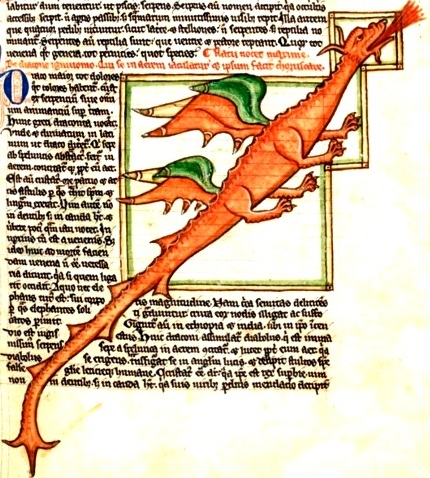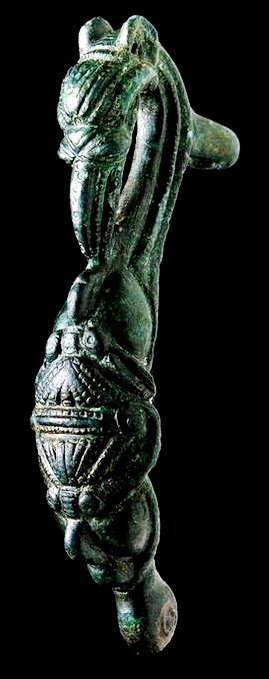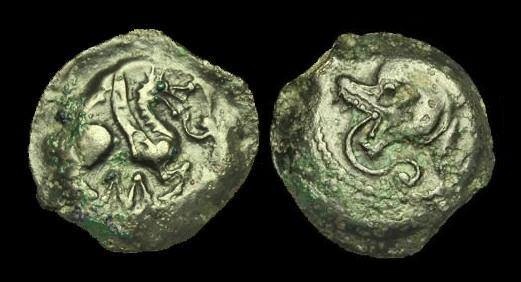A search on the online encyclopedia Wikipedia will reveal to the curious that, “The modern, western image of a dragon developed in western Europe during the Middle Ages through the combination of the snakelike dragons of classical Graeco-Roman literature, references to Near Eastern European dragons preserved in the Bible, and western European folk traditions”. We are also reliably informed by anonymous ‘experts’ that, “The oldest recognizable image of a fully modern, western dragon appears in a hand-painted illustration from the bestiary MS Harley 3244, which was produced in around 1260 AD”.
https://en.wikipedia.org/wiki/Dragon#Western_Europe
(Accessed 24/3/2018)
MS Harley 3244 – “The First European Depiction of a Dragon”
What is understood by a ‘fully modern dragon’ is debatable, but as with many historical and archaeological “facts” pertaining to European culture. presented on a medium from which the vast majority of today’s generation form their perception of the past, the conclusions presented on the tradition and origin of dragonesque creatures in Europe are hopelessly inaccurate and misleading.
In fact, even a quick overview of the actual archaeological evidence reveals that depictions of dragonesque creatures are common in Europe from the Iron Age onwards, appearing on jewelry, coinage, weapons and other artifacts throughout the La Tène period in particular.
Double-headed dragonesque / serpentine creature depicted on a decorative bronze element discovered in a Celtic chariot burial at Cuperly (Marne), France
(5th c. BC)
Bronze Celtic fibula from Pilsen in the Czech Republic (5th c. BC)
Dragonesque fibula (bronze) from a Celtic burial at Arbedo (Ticino), Switzerland (4 c. BC)
As with all aspects of Celtic art, the stylistic execution of such dragonesque creatures varies greatly, from relatively naturalistic to quite schematic images such as the iconic “dragon-pair” images found across Europe on Celtic scabbards and other artifacts of the middle La Tène period.
Detail of decoration on a “dragon-pair” scabbard from a Celtic warrior burial at Chens-Sur-Léman (Haute-Savoie), France (late 4th/early 3rd c. BC)
“The Dragonmaster” – Exterior plate B of the Gundestrup cauldron
Potin (billon) coin minted by the Bituriges Tribe in central France (1 c. BC)
Thus, despite what some would have us believe, the dragonesque beasts which populate Medieval European literature / art and survive in the consciousness and popular culture of the modern world, derive not from “Graeco-Roman literature and Biblical sources”, but are the offspring of fantastic creatures born in the dark and shining fantasy of Celtic Europe…
Mac Congail








Could these dragon motifs possibly be a remnant of Old Europe tradition?
For sure
These dragons represented the age of the constellation in which they were influenced… Draconis.
Great evidence , good scholarship , along with the example of the ‘master of dragons’ god and the two-headed creature on one plate of the Celtic origin Scordisci tribal federation Gundestrup Cauldron.Perhaps in the Balkans or western Ukraine the occidental and oriental mythical dragons met , alongside the Griffin with Iranic western Scythian contact being either a carrier or barrier?

Interesting thoughts. Had forgotten about him. Thanks Scotti.
I look forward to your posts so much! They’re always thoroughly researched and well written. It’s nice to see the Celtic heartland remembered, rather than just the “latecomers” of the British isles. Thanks for writing this blog!
In The BeGinninG
Is
The Worm
“Thus, despite what some would have us believe, the dragonesque beasts which populate Medieval European literature / art and survive in the consciousness and popular culture of the modern world, derive not from “Graeco-Roman literature and Biblical sources”, but are the offspring of fantastic creatures born in the dark and shining fantasy of Celtic Europe…” … This couldn’t be more wrong. Even the NAME ‘dragon” its etymology is Greek – “from Greek drakon (genitive drakontos) “serpent, giant seafish,”
Let me add some links to images of mythological ancient Greek dragons –
https://www.eleftherostypos.gr/wp-content/uploads/2017/02/ceb7cf81ceb1cebacebbceaecf82-cebbceb5cf81cebdceb1ceafceb1-cf8dceb4cf81ceb1-1.jpg – Lernaia Hydra, the 9 headed creature said to have been finally slain by Hercules.
https://www.eleftherostypos.gr/wp-content/uploads/2017/02/cebacebfcebbcf87ceb9cebacf8ccf82-ceb4cf81ceaccebacf89cebd1-1.jpg – Kolhic Dragon – The creature that guarded the golden fleece, at Kolhis, the one that Jason had to face.
More from Wikipedia – https://en.wikipedia.org/wiki/Dragons_in_Greek_mythology
Dragons also existed in Mesopotamian and, of course, Chinese lore and cultures.